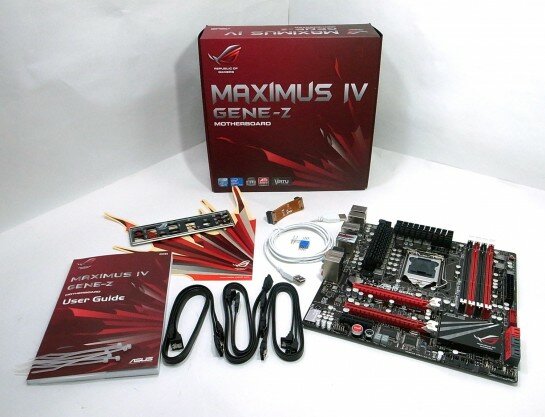Good things come in small packages
Like its big brother the Maximus IV Extreme-Z, the Maximus IV GENE-Z is based on the new Intel Z68 chipset. This gives both overclocking and the integrated Intel processor graphics support at the same time, for either display switching or using the Intel Quick Sync Video tech.
As with other boards in the GENE series this is a micro ATX board, which means that case modders can show off their creative side, and yet they will still be able to throw down at a LAN party. Let’s take a step back though and dig into this box of mini-goodness; what do you actually get when you buy a Maximus IV GENE-Z?
Unboxing the Maximus IV GENE-Z
Opening up we have the motherboard on top and all the bundled accessories underneath it. For accessories, we have an assortment of manual, driver disk, ROG ‘splash’ case sticker, a white USB cable for ROG Connect, SATA cables, SATA stickers and zip ties for cable management, an SLI cable and a ROG branded I/O port cover.
The board is nicely laid out in the usual ROG black and red color scheme that still packs a ton of features despite its micro ATX size. The heatsinks are nice and solid without crowding the space of the CPU socket, so installing/removing CPU heatsinks shouldn’t be an issue. Adjacent to the CPU are the DIMM slots, which can support up to 16GB of DDR3 memory overclocked to 2200MHz and beyond. Right next to it is the little red Go Button for overclockers so they can switch pre-saved UEFI setups on the fly when benchmarking.
Moving along down the side of the board, we have additional connections for two more USB 3.0 front panel ports, as well as two 6.0 Gb/s and two 3.0Gb/s SATA connections. At the bottom of the board we have the Start and Reset buttons for those who work with an open case and the Debug LEDs for troubleshooting when overclocking doesn’t go as planned. Rounding out the bottom of the board is a SupremeFX X-Fi2 audio chip. There’s space for two PCI-E 16x slots as so added graphics cards can run in either SLI or CrossFireX mode, while below them is an open-ended PCI-E 4x slot for high-performance add-in cards.
On the rear I/O ports there are the usual PS2 ports (for benchmarkers who like to disable USB entirely), a clear CMOS button, eight USB 2.0 ports and two USB 3.0 connections with one of the USB 2.0 ports dedicated for ROG Connect. In addition there are two eSATA 3.0 Gb/s ports, an Intel Ethernet LAN port, HDMI out (for use with Lucid Virtu) an optical audio out and finally the gold-plated 3.5mm audio jacks for the aforementioned SupremeFX X-Fi2 audio.
Whew. All that packed onto a micro-ATX board, and that’s still before we cover the software features! All your favorite ROG overclocking tools are onboard, as well as some new features like the just-launched Mem TweakIt and the GPU.DIMM Post – both of which are unique to LGA1155 ROG boards.
Another welcome addition is GameFirst technology, which prioritizes network data for games over downloads, web surfing or whatever else can tie up traffic. Finally, with the Z68 chipset Lucid Virtu enables the full functionality of the second generation Core and integrated processor graphics alongside any discrete PCI-E graphics card. This way you get access to the extra performance when transcoding video from Intel’s Quick Sync Video, while still getting all the gaming power of the discrete card when that’s needed.
Let us know if you’re planning to buy or have bought the new GENE-Z in the comments below, or, follow ROG on Facebook.
Related Articles
-
http://twitter.com/cloudsmesh Vishal







